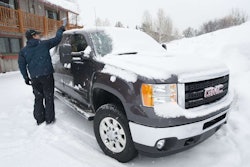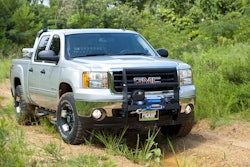GM 1500 4×4 Disc Brake Conversion
Rear drum-to-disc brake conversion is easy with the SSBC Chevy/GMC 1500 Truck Stop kit; triple-piston rotors and slotted calipers provide greater stopping power for 5.3 Ls.
By Bruce W. Smith
 For 99 percent of late-model GM half-ton pickup owners running the 5.3L in the construction world, the factory front-disc/rear-drum brake setup is perfectly fine.
For 99 percent of late-model GM half-ton pickup owners running the 5.3L in the construction world, the factory front-disc/rear-drum brake setup is perfectly fine.
But for that 1 percent who tow equipment trailers with surge-type brakes, do a lot of driving in mountainous regions, spend half their time off pavement, run bigger tires, do a lot of stop-and-go driving, or just want the optimum in braking power in an emergency situation, rear drum brakes just don’t cut it.
We are that 1 percent.
Like many landscapers, contractors, and fleet managers within our ProPickup audience, we enjoy improving the efficiency of pickups with upgrades that make the tasks at hand go a little smoother and the truck perform a little better.
Better braking efficiency is high on that upgrade list.
A MATTER OF HEAT
Disc brakes offer superiority over disc/drum setups during long grade-braking with a load because rotors dissipate heat better than drums, according to Howard Smith, GMC chassis controls and ABS engineer.
Better heat dissipation allows the pickup’s dynamic rear proportioning (DRP) or electronic brake force distribution (EBD) algorithms to apply more braking power to the rear discs so they share a bigger portion of the work load. This means less brake pad wear on the front.
Smith says “Discs at all four corners provide better linear (straight line) vehicle control in full lock-up situations because the pads release/apply from the rotor quicker than brake shoes inside drums.”
“With the rear brakes doing more work, or being more effective, the front brakes will have to work less,” says Michael Jonas, president of Stainless Steel Brake Corp. (SSBC).
“When brakes work less, they generate less heat, so they last longer. This extends duty cycles and pad/rotor life by as much as 50 percent.”
But GM’s 1500s with the 5.3L have discs in front, drums in the rear. An upgrade is in order.
The concern here, according to GM’s Smith, is the truck’s “non-linear” braking and traction control will work differently after a drum-to-disc swap.
“On low-coefficient surfaces (gravel, mud, sand, and snow) the vehicle may step-out more than it should because our electronic brake control (EBC) doesn’t know there are disc brakes back there instead of drums,” explains Smith. “So the brake modeling algorithms we use for fluid volume and line pressure for the discs are different than drums.”
Smith says the 1500s with the 6.2L, which have disc brakes all around, use the same EBC control module as the 5.3L. The difference is the 1500s with the 6.2L are programmed with an algorithm designed for discs instead of disc/drums.
SSBC, on the other hand, has done extensive testing of the GM drum-to-disc conversion over the years and have yet to see any results other than improved braking efficiency and reductions in brake repair costs with the upgrade.
Reports from their pickup customer’s reflect the same level of satisfaction.
“Don’t worry, after thousands of test miles, we have found the stock GM BCM brake program, ABS, and other brake functions work perfectly fine with our SSBC pickup brake upgrades,” Jonas assures.
DISC/DISC CONVERSION
Most contractors who are towing heavy loads behind 2007-newer GMC/Chevy 5.3L 1500s would love to have faster-acting brakes while reducing down time and expenses related to brake-maintenance costs.
That’s why we turned to SSBC to put its drum-to-disc conversion to the test under Project Bedrock, our 2011 Sierra Crew Cab 4×4.
SSBC’s American-made Truck Stop Tri-Power three-piston disc brake conversion kit (A126-57) replaces the drum setup with slotted 14-inch rotors and massive three-piston aluminum calipers sporting high-performance pads.
For a little more show, we opted for the red powder-coated calipers. They don’t make the truck stop any faster, but they do make an immediate performance statement.
Upgrading from the standard disc/drum configuration found under the later model GM 1500s to SSBC’s Truck Stop disc/disc kit is a straightforward process that takes a good shop mechanic about a half-day to complete.
The R&R of the GM rear axles eats up a chunk of that time because of the “C”-clip design, which requires opening up the rear differential to remove the axles.
(If you wanted a heavy-duty diff cover, now’s the time to install it.)
RED MEANS STOP
SSBC’s rear drum-to-disc conversion kit comes with all the mounting hardware, braided brake lines and detailed instructions to help guide the DIYer who might be doing this for the first time.
David Adair, one of the techs at Truck Supply & Outfitters here in Tuscaloosa, Ala., handled our drum-to-disc brake upgrade.
Adair also upgraded Project Bedrock’s front brakes by swapping out the OEM disc brake setup for SSBC’s Truck Stop Tri-Power calipers and slotted rotors (A126-56).
This gives our GMC about 30-percnt greater front clamping power while reducing both pad and rotor wear.
Overall, the SSBC disc brakes have given our GMC Sierra a feeling of more braking control with less pedal effort; it tends to squat instead of nose-dive under braking.
Brake pad service is going to be less now that the braking load is being shared more equally front and rear.
Our how-to shows the main steps of the conversion. (If you want to see the complete step-by-step, go to propickupmag.com/project-trucks/bedrock/installs.)
SOURCES:
SSBC Performance Brake Systems; 800-448-7722
Truck Supply & Outfitters; 205-553-4203







